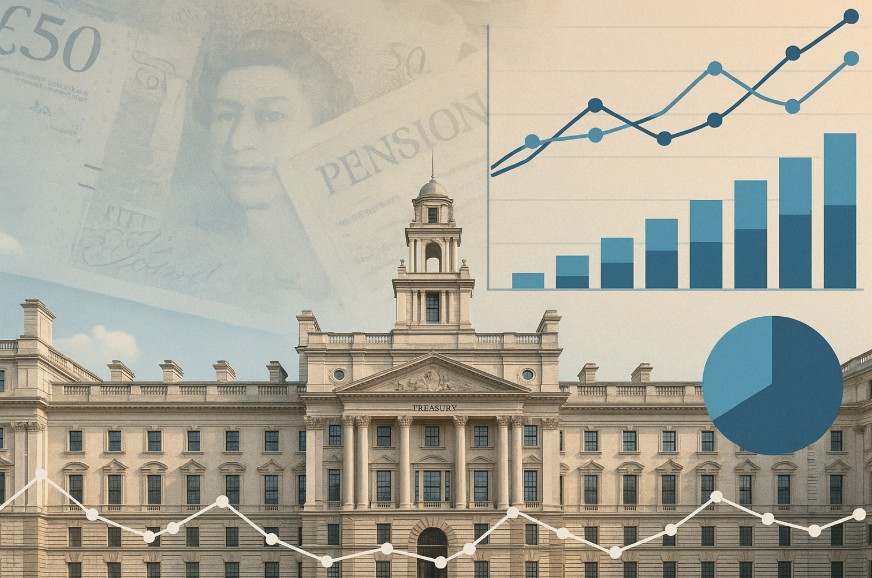The UK’s state pension framework is undergoing a pivotal transformation, capturing the attention of policymakers, economists, and the public alike.
As fiscal pressures mount and demographic shifts continue to reshape national priorities, changes to long-standing retirement norms are inevitable.
A particular move by the current Chancellor has prompted significant debate, stirring concerns and curiosity across the country.
These developments point to broader shifts in government policy, personal finance planning, and the evolving social contract between citizens and the state.
What Are the Key Highlights of Rachel Reeves’ Pension Reform?

Rachel Reeves, as Chancellor, has outlined a significant reform to the UK pension system by proposing an increase in the state pension age from 66 to 67 by 2029–30.
This policy is expected to deliver a major reduction in government expenditure related to pension benefits.
The Office for Budget Responsibility (OBR) has projected that this change will result in savings of £10.4 billion during the specified financial year.
The majority of this figure comes from delaying pension payments to a large segment of the population—specifically, those reaching age 66.
This decision forms part of Labour’s wider fiscal framework, focusing on long-term sustainability of public finances while also addressing the growing costs associated with an ageing population.
How Will the Increase in State Pension Age Impact Government Finances?
The decision to raise the state pension age to 67 by 2029–30 is projected to have a profound financial impact on UK public finances.
At the heart of this policy is a strategic effort to reduce long-term government spending by altering the age at which citizens become eligible for pension benefits.
According to projections from the Office for Budget Responsibility (OBR), this change will result in substantial annual savings of approximately £10.4 billion.
Breakdown of the Financial Savings
A large proportion of these savings, around £10.2 billion will come from reducing the number of people who begin receiving their state pension at age 66.
Under current policy, individuals begin collecting their state pension at 66, but this reform delays access until age 67.
This one-year delay means that nearly 820,000 people who would have received state pension payments in 2029–30 will no longer be eligible within that financial year.
In addition to the reduction in pension recipients, the government is expected to save an additional £0.2 billion by limiting access to related welfare programmes for this same age group. These programmes include:
- Pension Credit, a means-tested top-up for low-income pensioners.
- Winter Fuel Payment, a seasonal benefit to help older adults manage energy costs.
By extending the working-age period by a year, these supplementary supports are deferred alongside the pension, thereby amplifying overall savings.
Fiscal Efficiency Through Eligibility Control
This policy operates on a simple financial principle: by narrowing the window of eligibility and postponing when people enter the pension system, the state limits its annual obligations.
Unlike cuts to the pension amount, which could spark political and public backlash—raising the eligibility age is a more targeted method of controlling costs.
It applies uniformly and predictably, allowing the Treasury to better model long-term fiscal forecasts.
Moreover, the magnitude of the projected savings is not only significant in raw numbers but also in relative terms.
The OBR has indicated that £10.4 billion in savings would account for 5.7 per cent of total pensioner-related spending in that financial year.
That figure underscores the scale of the impact and the importance of this policy in the context of broader economic planning.
Policy Timing and Budget Alignment
The timing of this reform is also crucial. The increase in pension age coincides with a period of tightening fiscal headroom for the UK government.
As borrowing costs rise and economic growth slows, policymakers face pressure to demonstrate fiscal responsibility.
The pension age reform offers a high-yield, politically manageable lever for generating budgetary space without reducing the overall value of benefits in the long term.
This allows the Chancellor, Rachel Reeves, to present a fiscally responsible position while still maintaining Labour’s social welfare commitments.
The savings can be reallocated towards other underfunded sectors such as health, education, and infrastructure, supporting Labour’s broader agenda of economic transformation.
Comparative Insights
Raising the pension age is not unique to the UK. Several other advanced economies have adopted similar policies in response to increased life expectancy and the growing ratio of retirees to working-age individuals.
By aligning the UK’s retirement age more closely with demographic realities, the policy mirrors a global trend toward pension sustainability.
The UK’s fiscal landscape, characterised by a large and ageing population, demands such reforms to avoid placing excessive pressure on future taxpayers.
Without changes like this, the increasing burden of pension obligations could crowd out other essential government spending.
Why Will Fewer 66-Year-Olds Receive Pension Benefits?

The main effect of the raised pension age is the exclusion of 66-year-olds from state pension eligibility for an additional year.
These individuals, under previous regulations, would have started receiving payments upon turning 66. Under the new framework, they must wait until they are 67.
This shift leads to substantial savings, primarily due to the reduced number of claimants. Additionally, it decreases the number of individuals eligible for related benefits such as Pension Credit and Winter Fuel Payment.
Estimated impact:
| Age Group | Reduction in Recipients | Estimated Savings |
| Age 66 (State Pension) | 820,000 fewer recipients | £10.2 billion |
| Pension Credit & Winter Fuel | 40,000 fewer recipients | £0.2 billion |
This approach helps the government limit expenses without changing the amount of pension paid per recipient, instead adjusting when individuals become eligible.
Will There Be Any Additional Costs to Offsetting These Savings?
Although the government saves significantly on pension-related spending, these savings are partially offset by new costs incurred through other benefit systems.
Individuals aged 66, who are not yet eligible for a pension, will remain eligible for working-age benefits such as Universal Credit.
The OBR estimates this will cost the Treasury around £700 million in the 2029–30 financial year.
This figure is based on assumptions about current benefit uptake rates, particularly the 7.4 per cent of 66-year-olds currently receiving Universal Credit.
Important factors include:
- Universal Credit rates for 66-year-olds will be similar to those for 65-year-olds.
- The delay in pension eligibility extends the duration of Universal Credit dependency.
These working-age benefits, while smaller in amount per recipient than pensions, still represent a significant expenditure due to the volume of individuals affected.
How Could Raising the State Pension Age Influence Employment and Taxes?

One of the broader objectives of increasing the state pension age is to encourage older individuals to remain in the workforce.
Historical data supports the notion that raising the eligibility age results in higher employment levels among those nearing retirement.
An earlier shift in pension age from 65 to 66 yielded:
- A 7.4 percentage point increase in employment among men.
- An 8.5 percentage point increase among women.
- Around 55,000 additional 65-year-olds stayed in work.
- An average increase of £52 per week in earnings for this group.
The potential for increased labour market participation among 66-year-olds could boost tax revenues significantly. The OBR projects that this could generate an additional £0.9 billion in income tax and National Insurance contributions by 2029–30.
Labour Market Impact Table:
| Metric | Increase/Impact |
| Male employment rate at age 65 | +7.4 percentage points |
| Female employment rate at 65 | +8.5 percentage points |
| Additional workers (age 65) | +55,000 individuals |
| Average weekly earnings | +£52 per person |
| Projected tax revenue (2029–30) | £0.9 billion |
These figures suggest that the pension age rise may not only reduce public spending but also enhance revenue collection, creating a dual fiscal benefit.
What Are the Broader Economic and Fiscal Implications for the Treasury?
This pension policy is part of Labour’s long-term fiscal consolidation strategy, addressing both current financial challenges and the rising cost of an ageing population. By raising the state pension age, Rachel Reeves aims to realign public expenditure with demographic and economic realities.
The savings and increased tax revenue will improve the Treasury’s ability to invest in essential public services and reduce reliance on borrowing. Additionally, keeping older individuals in the workforce helps fill labour shortages in various sectors.
This strategic approach gives the government more flexibility in managing its budget while maintaining commitments to social welfare.
Are People in the UK Ready for These Changes?
While the policy may make economic sense, public preparedness remains a concern. Research by Standard Life has highlighted major gaps in pension awareness among UK citizens.
Findings include:
- Half of UK adults do not know how much their state pension will be.
- Nearly a third are unaware of the age at which they will receive it.
These knowledge gaps could lead to financial stress for those expecting to retire at 66 under current assumptions.
People may find themselves unprepared to support themselves financially for the extra year before pension eligibility.
This situation highlights the need for improved communication and education about retirement planning, especially as policy changes take effect.
What Should Individuals Do to Prepare for Later Retirement?

Given the changes to pension eligibility and growing life expectancy, individuals are encouraged to take active steps in managing their retirement plans.
Relying solely on the state pension may no longer be viable for a comfortable post-retirement lifestyle.
Key actions to consider:
- Begin saving early into a personal or workplace pension.
- Use official tools to check your state pension forecast.
- Adjust retirement timelines based on updated eligibility rules.
- Consult financial advisors for personalised retirement planning.
As emphasised by the Pensions and Lifetime Savings Association, the state pension provides only a basic income level and should be viewed as part of a broader retirement strategy. This includes saving privately to bridge the gap between desired and actual retirement income.
Conclusion
Rachel Reeves’ proposal to raise the state pension age to 67 represents a pivotal shift in the UK’s public finance strategy.
The projected £10.4 billion in savings offers substantial fiscal relief, giving the Treasury new opportunities to rebalance the national budget. However, the implications for individuals are considerable, especially those nearing retirement without adequate savings.
The measure will affect eligibility, employment, benefit distribution, and overall retirement security. As the government pushes forward, it becomes increasingly vital for individuals to stay informed and plan proactively for their financial futures.
FAQs About Rachel Reeves’ Pension Changes
What is the new state pension age under Rachel Reeves’ plan?
The state pension age is proposed to increase to 67 by 2029–30, up from the current age of 66.
How many people will be affected by the pension age increase?
Approximately 820,000 fewer individuals aged 66 will qualify for the state pension once the changes are in effect.
Will the pension changes save the government money?
Yes, the government is projected to save £10.4 billion in 2029–30 through reduced pension payouts and associated benefits.
Are there additional government costs due to the delay in pension age?
Yes, there will be increased costs for working-age benefits, estimated at £700 million, as 66-year-olds may claim Universal Credit instead.
How will this policy affect employment among older adults?
Raising the pension age is expected to increase employment rates among those in their mid-60s, potentially raising tax revenues by £0.9 billion.
Are UK citizens generally aware of their pension entitlements?
Studies show that 50% of adults don’t know how much they’ll receive from the state pension, and about one-third don’t know the eligibility age.
What can individuals do to prepare for these changes?
UK residents should consider supplementing their retirement income with workplace or personal pensions and stay informed through official pension forecasts.








